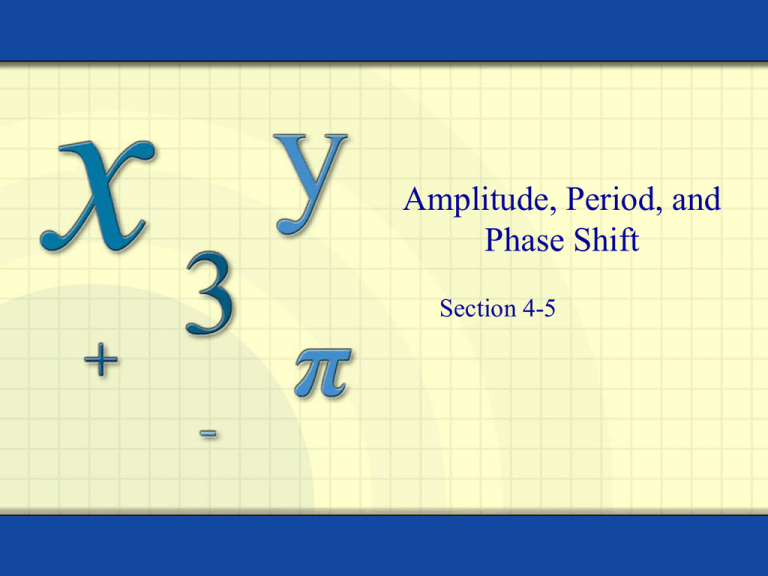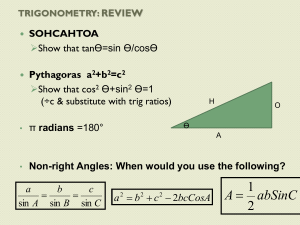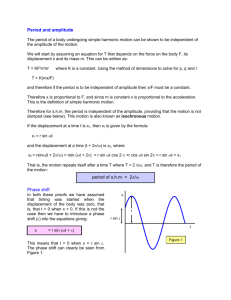
Amplitude, Period, and
Phase Shift
Section 4-5
Objectives
• I can determine amplitude,
period, and phase shifts of trig
functions
• I can write trig equations given
specific period, phase shift, and
amplitude.
2
Section 4.5: Figure 4.49, Key
Points in the Sine and Cosine
Curves
3
Radian versus Degree
• We will use the following to graph or write
equations:
– “x” represents radians
– “” represents degrees
– Example: sin x versus sin
4
a sin b( x ps ) d
Amplitude
Period:
2π/b
Phase Shift:
Left (+)
Right (-)
Vertical Shift
Up (+)
Down (-)
5
The Graph of y = AsinB(x - C)
The graph of y = A sin B(x – C) is obtained by horizontally shifting the graph
of y = A sin Bx so that the starting point of the cycle is shifted from x = 0 to
x = C. The number C is called the phase shift.
y
amplitude = | A|
period = 2 /B.
y = A sin Bx
Amplitude: | A|
x
Starting point: x = C
Period: 2/B
Copyright © by Houghton Mifflin Company, Inc. All rights reserved.
6
The amplitude of y = a sin x (or y = a cos x) is half the distance
between the maximum and minimum values of the function.
amplitude = |a|
If |a| > 1, the amplitude stretches the graph vertically.
If 0 < |a| > 1, the amplitude shrinks the graph vertically.
If a < 0, the graph is reflected in the x-axis.
y
4
y = 2 sin x
2
y=
1
2
3
2
2
x
sin x
y = – 4 sin x
reflection of y = 4 sin x
y = sin x
y = 4 sin x
4
7
The period of a function is the x interval needed for the
function to complete one cycle.
For b 0, the period of y = a sin bx is 2 .
b
For b 0, the period of y = a cos bx is also 2 .
b
If 0 < b < 1, the graph of the function is stretched horizontally.
y
y sin 2
period: 2
period:
y sin x x
2
If b > 1, the graph of the function is shrunk horizontally.
y
y cos x
1
y cos x
period: 2
2
2
3
4
x
period: 4
8
Use basic trigonometric identities to graph y = f (–x)
Example 1: Sketch the graph of y = sin (–x).
The graph of y = sin (–x) is the graph of y = sin x reflected in
the x-axis.
y = sin (–x)
y
Use the identity
sin (–x) = – sin x
y = sin x
x
2
Example 2: Sketch the graph of y = cos (–x).
The graph of y = cos (–x) is identical to the graph of y = cos x.
y
Use the identity
x
cos (–x) = cos x
2
y = cos (–x)
9
Example
Determine the amplitude, period, and phase shift of
y = 2sin (3x - )
Solution:
First factor out the 3
y = 2 sin 3(x - /3)
Amplitude = |A| = 2
period = 2/B = 2/3
phase shift = C/B = /3 right
10
Find Amplitude, Period, Phase Shift
• Amplitude (the # in front of the trig. Function
• Period (360 or 2 divided by B, the #after the trig function
but before the angle)
• Phase shift (the horizontal shift after the angle and inside
the parenthesis)
•
y = 4sin
y = 2cos1/2
y = sin (4x - )
Amplitude:
4
2
Phase shift:
Period:
NA
360
NA
720
1
( Right )
4
2
11
Example: Sketch the graph of y = 3 cos x on the interval [–, 4].
Partition the interval [0, 2] into four equal parts. Find the five key
points; graph one cycle; then repeat the cycle over the interval.
x
y = 3 cos x
y
(0, 3)
2
1
0
3
0
-3
x-int
min
2
max
3
2
0
2
3
x-int
max
(2, 3)
1
( , 0)
2
2
3
( , –3)
2
( 3 , 0)
2
3
4 x
12
Writing Equations
• Write an equation for a positive sine curve with an
amplitude of 3, period of 90 and Phase shift of 45 left.
• Amplitude goes in front of the trig. function, write the
eq.so far:
• y = 3sin
360
360
• period is 90. use P =
90, so B
4
B
90
•
• rewrite the eq.
• y = 3 sin4
• 45 degrees left means +45
• Answer: y = 3sin4( + 45)
13
Writing Equations
• Write an equation for a positive cosine curve with an
amplitude of 1/2, period of 4 and Phase shift of right .
• Amplitude goes in front of the trig. function, write the
eq.so far:
• y = 1/2cos x
2
2 4
• period is /4. use P =
, so B
8
B
4
1
•
• rewrite the eq.
• y = 1/2cos 8x
• right is negative, put this phase shift inside the
parenthesis w/ opposite sign.
• Answer: y = 1/2cos8(x - )
14
Homework
• Trig Value Table
• WS 7-1
• Quiz next class
15






